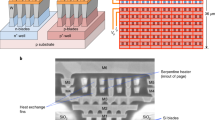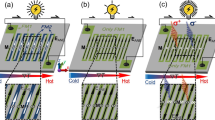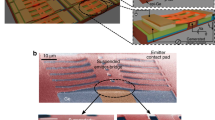Abstract
Microelectromechanical systems (MEMS) are the basis of many rapidly growing technologies, because they combine miniature sensors and actuators with communications and electronics at low cost. Commercial MEMS fabrication processes are limited to silicon-based materials or two-dimensional structures. Here we show an inexpensive, electrochemical technique to build MEMS-like structures that contain several different metals and semiconductors with three-dimensional bridging structures. We demonstrate this technique by building a working microthermoelectric device. Using repeated exposure and development of multiple photoresist layers, several different metals and thermoelectric materials are fabricated in a three-dimensional structure. A device containing 126 n-type and p-type (Bi, Sb)2Te3 thermoelectric elements, 20 μm tall and 60 μm in diameter with bridging metal interconnects, was fabricated and cooling demonstrated. Such a device should be of technological importance for precise thermal control when operating as a cooler, and for portable power when operating as a micro power generator.
This is a preview of subscription content, access via your institution
Access options
Subscribe to this journal
Receive 12 print issues and online access
$259.00 per year
only $21.58 per issue
Buy this article
- Purchase on Springer Link
- Instant access to full article PDF
Prices may be subject to local taxes which are calculated during checkout




Similar content being viewed by others
References
Bishop, D., Heuer, A. & Williams, D. Microelectro-mechanical systems: Technology and applications. Mater. Res. Bull. 26, 282–282 (2001).
Kupka, R.K., Bouamrane, F., Cremers, C. & Megtert, S. Microfabrication: LIGA-X and applications. Appl. Surf. Sci. 164, 97–110 (2000).
Cohen, A. et al. in Proc. SPIE - The International Society for Optical Engineering Vol. 3874 236–247 (SPIE, Santa Clara, California, USA, 1999).
Rowe, D.M. (ed.) Thermoelectric Handbook (CRC, Boca Raton, 1995).
Venkatasubramanian, R., Siivola, E., Colpitts, T. & O'Quinn, B. Thin-film thermoelectric devices with high room-temperature figures of merit. Nature 413, 597–602 (2001).
Harman, T.C., Taylor, P.J., Walsh, M.P. & LaForge, B.E. Quantum dot superlattice thermoelectric materials and devices. Science 297, 2229–2232 (2002).
Böttner, H. in Proc. Twenty-first International Conference on Thermoelectrics, ICT'02 511–518 (IEEE, Long Beach, California, USA, 2002).
Martin-Gonzalez, M.S., Prieto, A.L., Gronsky, R., Sands, T. & Stacy, A.M. Insights into the electrodeposition of Bi2Te3 . J. Electrochem. Soc. 149, C546–C554 (2002).
Fleurial, J.-P. et al. in Proc. Eighteenth International Conference on Thermoelectrics, ICT'99 294–300 (IEEE, Baltimore, Maryland, USA, 1999).
Lim, J.R. et al. in Proc. Twenty-first International Conference on Thermoelectrics, ICT'02 535–539 (IEEE, Long Beach, California, USA, 2002).
Fleurial, J.-P. et al. in Proc. Twentieth International Conference on Thermoelectric,s ICT'01 24–29 (IEEE, Beijing, China, 2001).
Snyder, G.J., Fleurial, J.-P., Caillat, T., Yang, R. & Chen, G. Supercooling of Peltier cooler using a current pulse. J. Appl. Phys. 92, 1564–1569 (2002).
Schaevitz, S.B., Franz, A.J., Jensen, K.F. & Schmidt, M.A. in Proc. 11th International Conference on Solid State Sensors and Actuators Transducers '01/Eurosensors XV Vol. 1 30–33 (ed. Obermeier, E.) (Springer, Munich, Germany, 2001).
Zhang, C., Najafi, K., Bernal, L.P. & Washabaugh, P.D. in Proc. 11th International Conference on Solid State Sensors and Actuators Transducers '01/Eurosensors XV Vol. 1 (ed. Obermeier, E.) 34–37 (Springer, Munich, Germany, 2001).
Kishi, M. et al. in Proc. Eighteenth International Conference on Thermoelectrics, ICT'99 301–307 (IEEE, Baltimore, Maryland, USA, 1999).
Foote, M.C., Jones, E.W. & Caillat, T. Uncooled thermopile infrared detector linear arrays with detectivity greater than 109 cmHz½/W. IEEE Trans. Electron Dev. 45, 1896–1902 (1998).
Acknowledgements
This work is supported by the US Defense Advanced Research Projects Agency and the Office of Naval Research. This work was carried out at the Jet Propulsion Laboratory, California Institute of Technology, under contract with the National Aeronautics and Space Administration.
Author information
Authors and Affiliations
Corresponding author
Ethics declarations
Competing interests
The authors declare no competing financial interests.
Rights and permissions
About this article
Cite this article
Snyder, G., Lim, J., Huang, CK. et al. Thermoelectric microdevice fabricated by a MEMS-like electrochemical process. Nature Mater 2, 528–531 (2003). https://doi.org/10.1038/nmat943
Received:
Accepted:
Published:
Issue Date:
DOI: https://doi.org/10.1038/nmat943
This article is cited by
-
A large-area bionic skin for high-temperature energy harvesting applications
Nano Research (2023)
-
Micro-thermoelectric devices
Nature Electronics (2022)
-
Laser ablation assisted micropattern screen printed transduction electrodes for sensing applications
Scientific Reports (2022)
-
Preparation and doping modification of cerium oxide photosensitizers applied to photosensitive glass ceramics
Journal of Materials Science: Materials in Electronics (2022)
-
Heat source free water floating carbon nanotube thermoelectric generators
Scientific Reports (2021)



